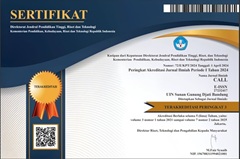MOOD TYPES OF DONALD TRUMP’S SPEECH IN THE ARAB ISLAMIC AMERICAN SUMMIT
DOI:
https://doi.org/10.15575/call.v3i1.12531Abstract
This research deals with analyzing language from the perspective of Systemic Functional Linguistics (SFL) from Donald Trump’s speech in the Arab Islamic American Summit. In English, one of types of meaning is Interpersonal meaning. It is realized by mood and modality. This research focuses on mood, then formulated into two research questions: 1) What mood types are used in Donald Trump’s speech in the Arab Islamic American summit? 2) What mood adjuncts are used in Donald Trump’s speech in the Arab Islamic American Summit?. The method used in this research is qualitative research. The source of data is the video of Donald Trump’s speech from Youtube. It was taken from (CNN, 2017) to get the transcript of speech by Donald Trump. It was found that there were 355 clauses in Donald Trump’s speech; there were 4 types of mood in the speech of Donald Trump; there were 337 declaratives mood with percentage 94.92%, 4 Polar-Interrogatives mood with percentage 1.12%, 4 WH-Interrogatives mood with percentage 1.12% and 10 imperatives mood with percentage 2.25%. Declarative as the most dominant types of mood is used in Donald Trump’s, speech which means that he gave or stated information to the audiences. In addition, in Donald Trump’s speech, there are 19 clauses which contain mood adjunct. The findings indicated that there were 3 types of mood adjunct in the speech, namely, 5 adjuncts of modality with percentage 26.31%, 3 adjuncts of temporality with percentage 15.78%, and 11 adjuncts of intensity with percentage 57.89%. The most dominant is adjuncts of intensity which expresses expectation.
Â
Keywords: Systemic Functional Linguistics; Mood; Mood Adjunct
References
Almurashi, W. A. (2016). An Introduction to Halliday's Systemic FunctionaLinguistics. ResearchGate , 71.
Andani, D. N. (2019). The Mood Structure in Nadin Amizahs Instagram: A Systemic Functional Discourse Analysis. Language Horizon .
Ardiansah, D. (2015). An Analysis Of Modality In Students’ Hortatory Exposition Texts (Systemic Functional Grammar Perspective). journal of language and literature education .
Beekhuyzen, D. J. (2008). Retrieved from Androit Research: https://www.adroitresearch.com.au/what-is-qualresearch
Beverley Hancock. Elizabeth Ockleford, K. W. (2009). An Introduction to Qualitative Research. Nottingham: The NIHR RDS EM / YH.
CNN. (2017, may 21). Transcript of Trump's Speech in Saudi Arabia. Retrieved from cnn.com: https://edition.cnn.com/2017
David Butt, R. F. (1999). Using Functional Grammar. Sydney: National Centre for English Language Teaching and Research Macquarie University.
Depraetere, i. (2008). Mood and Modality in English. ResearchGate .
Dornyei, Z. (2007). Research Methods in Applied Linguistics. newyork: Oxford University.
Duignan, B. (2017). Donald Trump President of the United Speech. Britannica .
Endarto, I. T. (2017). Systemic Functional Linguistic: A Brief Introduction. ResearchGate , 03.
Feng, Z. (2013). Functional Grammar and Its Implications for English Teaching and Learning . English language teahing .
Heydarnia, R. (2015). A comparative study of mood and modality in academic writing: male vs female authors of research articles in applied linguistics. International journal of Scientific & engineering Research , 87.
Kothari, C. (2004). Research Methodology Methods and Techniques. New Delhi: New Age.
Listiani, D. J. (1934). Speech Function on the Text Romeo and Juliet Drama. Knowledge E .
Martanto. Soerdjowardhana, C. W. (2014). The Speech Functions Analysis In Utterances Used By Alex Hitches And Sara Mendes In “Hitch†Movie. Udinus , 02.
Matthiessen, H. (2014). Halliday's Introduction to Functional Grammar. USA: Routledge.
Matthiessen, M. H. (2014). Halliday's Introduction to Functional Grammar. Newyork: Routledge.
Panggabean, C. I. (2011). An Introduction to Metafunctional Components of Language. Okara , 51.
Permata, A. F. (2015). Mood Types Analysis of Teaching and Learning Process in Immersion Class of Theresiana 1 Senior Hogh School.
Roghayeh Heydarnia, N. A. (2015). A Comparative Study of Mood and Modality in Academic Writing: Male vs. Female Authors of Research Articles in applied Linguistics. Scientific and engineering .
Salkie, R. (2015). F. R. Palmer, Mood and Modality. Journal of Linguistics , 240.
Suryana, A. (2016). Transitivity Analysis in Wikileaks Release: Trident Whistleblower Nuclear 'Disaster Waiting to Happen'.
Syafirah, D. (2017). An Analysis Of Interpersonal Meaning in Sri Mulyani Indrawati Speech. Retrieved from Repositori Institusi USU: http://repositori.usu.ac.id
Vause, J. S. (2018). American English: History, Structure, and Usage. Cambridge , 03.
Wignell, G. a. (1994). Making Sense of Functional Grammar. Australia: Gerd Stabler.
Wignell, L. G. (1995). Making Sense of Functional Grammar. Autralia: Gerd Stabler.
Yuliana, D. (2017). The Reization of Interpersonal Meaning in Course Newsletters: A Systemic Functional Linguistic Perspective. ResearchGate , 183.
Zaenul, F. (2014). Mood Structure Analysis of Teacher Talk in Efl Classroom: A Discourse study Based on Systemic Functional Linguistic Theory.
Downloads
Published
Issue
Section
Citation Check
License
Authors who publish in CALL agree to the following terms:
- Authors retain copyright and grant the journal right of first publication with the work simultaneously licensed under Attribution-ShareAlike 4.0 International (CC BY-SA 4.0) License that allows others to share the work with an acknowledgment of the work's authorship and initial publication in this journal.
- Authors are able to enter into separate, additional contractual arrangements for the non-exclusive distribution of the journal's published version of the work (e.g., post it to an institutional repository or publish it in a book), with an acknowledgment of its initial publication in this journal.
- Authors are permitted and encouraged to post their work online (e.g., in institutional repositories or on their website) prior to and during the submission process, as it can lead to productive exchanges, as well as earlier and greater citation of published work (See The Effect of Open Access).




